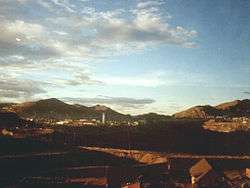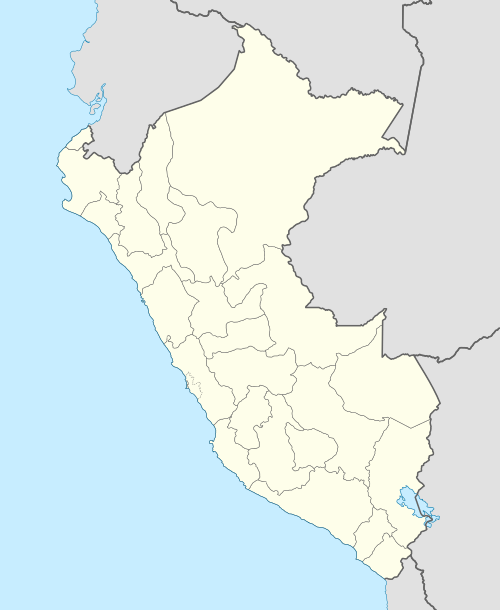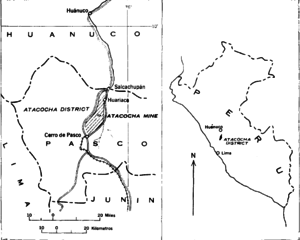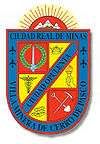Cerro de Pasco
| Cerro de Pasco | |||
|---|---|---|---|
| Town | |||
 Sunset at Cerro de Pasco. | |||
| |||
 Cerro de Pasco Location of in Peru | |||
| Coordinates: 10°41′11″S 76°15′45″W / 10.68639°S 76.26250°W | |||
| Country |
| ||
| Region | Pasco Region | ||
| Province | Pasco Province | ||
| Demonym | Cerreño(a) | ||
| Government | |||
| • Mayor | Jhoni Teodosio Ventura Rivadeneira | ||
| Elevation | 4,330 m (14,210 ft) | ||
| Population | |||
| • Estimate (2015)[1] | 66,272 | ||

Cerro de Pasco (population 70,000) is a city in central Peru, located at the top of the Andean mountains. It is the capital of the Pasco region, and an important mining center. At 4,330 metres (14,210 ft) elevation, it is one of the highest cities in the world, and the highest or the second highest city with over 50,000 inhabitants, with elevation reaching up to 4,380 m in the Yanacancha area. It is connected by road and by rail to the capital Lima, as far as 300 km.
Mining center
Cerro de Pasco became one of the world's richest silver producing areas after silver was discovered there in 1630.[2] It is still an active mining center. The Spanish mined the rich Cerro de Pasco silver-bearing oxide ore deposits since colonial times. Sulfide minerals are more common in the Atacocha district however.
Francisco Uville arranged for steam engines made by Richard Trevithick of Cornwall, England, to be installed in Cerro de Pasco in 1816 to pump water from the mines and allow lower levels to be reached. However, fighting in the Peruvian War of Independence brought production to a halt from 1820 to 1825.[3]
Three major mines in the area include the Machcan, Atacocha, and Milpo. SIlver ore occurs in hydrothermal veins or as sulfides and clay minerals replacing the Jurassic Pucara limestone. Porphyry dacite stocks are found intruded near the Atacocha and Milpo mines along the Atacocha Fault. Compania Minera Atacocha started operations at the Atacocha Mine in 1936. Ore minerals include galena and sphalerite.[4]
Contamination of the environment by lead, cadmium and other heavy metals has precipitated a public health crisis in the city, but a 2006 law proposing to evacuate all inhabitants and relocate the city has not yet culminated in concrete action.[5][6]
Geography
Climate
At 4,330 metres (14,210 ft) above sea level, Cerro de Pasco has an (E) Alpine tundra climate with the average temperature of the warmest month below the 10 °C (50 °F)) threshold that would allow for tree growth, giving the countryside its barren appearance. The city is the largest in the world with this classification. Cerro de Pasco has humid, damp and cloudy summers with frequent rainfall and dry, sunny winters with cool to cold temperatures throughout the year. Snowfall occurs sporadically during any season and is most commonly around dawn.
The average annual temperature in Cerro de Pasco is 5.5 °C and the average annual rainfall is 999 mm.
| Climate data for Cerro de Pasco | |||||||||||||
|---|---|---|---|---|---|---|---|---|---|---|---|---|---|
| Month | Jan | Feb | Mar | Apr | May | Jun | Jul | Aug | Sep | Oct | Nov | Dec | Year |
| Average high °C (°F) | 11.9 (53.4) |
10.9 (51.6) |
11.4 (52.5) |
12.9 (55.2) |
12.2 (54) |
12.7 (54.9) |
12.5 (54.5) |
12.9 (55.2) |
12.0 (53.6) |
12.4 (54.3) |
12.5 (54.5) |
13.0 (55.4) |
12.3 (54.1) |
| Daily mean °C (°F) | 6.2 (43.2) |
5.9 (42.6) |
6 (43) |
6.2 (43.2) |
5.1 (41.2) |
4.3 (39.7) |
4.3 (39.7) |
4.9 (40.8) |
5.2 (41.4) |
5.8 (42.4) |
5.9 (42.6) |
6.4 (43.5) |
5.5 (41.9) |
| Average low °C (°F) | 0.6 (33.1) |
0.9 (33.6) |
0.7 (33.3) |
−0.4 (31.3) |
−2.0 (28.4) |
−4.0 (24.8) |
−3.9 (25) |
−3.1 (26.4) |
−1.6 (29.1) |
−0.8 (30.6) |
−0.7 (30.7) |
−0.1 (31.8) |
−1.2 (29.8) |
| Average precipitation mm (inches) | 137 (5.39) |
151 (5.94) |
153 (6.02) |
80 (3.15) |
43 (1.69) |
14 (0.55) |
16 (0.63) |
26 (1.02) |
52 (2.05) |
98 (3.86) |
103 (4.06) |
126 (4.96) |
999 (39.32) |
| Source: Climate-data.org[7] | |||||||||||||
Important People
See also
References
- ↑ Perú: Población estimada al 30 de junio y tasa de crecimiento de las ciudades capitales, por departamento, 2011 y 2015. Perú: Estimaciones y proyecciones de población total por sexo de las principales ciudades, 2012-2015 (Report). Instituto Nacional de Estadística e Informática. March 2012. Retrieved 2015-06-03.
- ↑

- ↑ Fisher, John (February 1975), "Silver Production in the Viceroyalty of Peru, 1776-1824", The Hispanic American Historical Review, Published by: Duke University Press, 55 (1): 37–38, JSTOR 2512735
- ↑ Johnson, Robert; Lewis, Richard; Abele C., Guillermo (1955). Geology and Ore Deposits of the Atacocha District Departamento de Pasco Peru, USGS Bulletin 975-E, Geologic Investigations in the American Republics. Washington: United States Government Printing Office. pp. 337–387.
- ↑ Livingstone, Grace; Souesi, Jasmin (12 August 2018). "Is this city the most polluted on earth?". BBC News. Retrieved 12 August 2018.
- ↑ Dajer, Tony (2 December 2015). "High in the Andes, A Mine Eats a 400-Year-Old City". National Geographic. Retrieved 12 August 2018.
- ↑ "Climate: Cerro de Pasco". Retrieved 5 September 2013.
Coordinates: 10°41′11″S 76°15′45″W / 10.68639°S 76.26250°W
